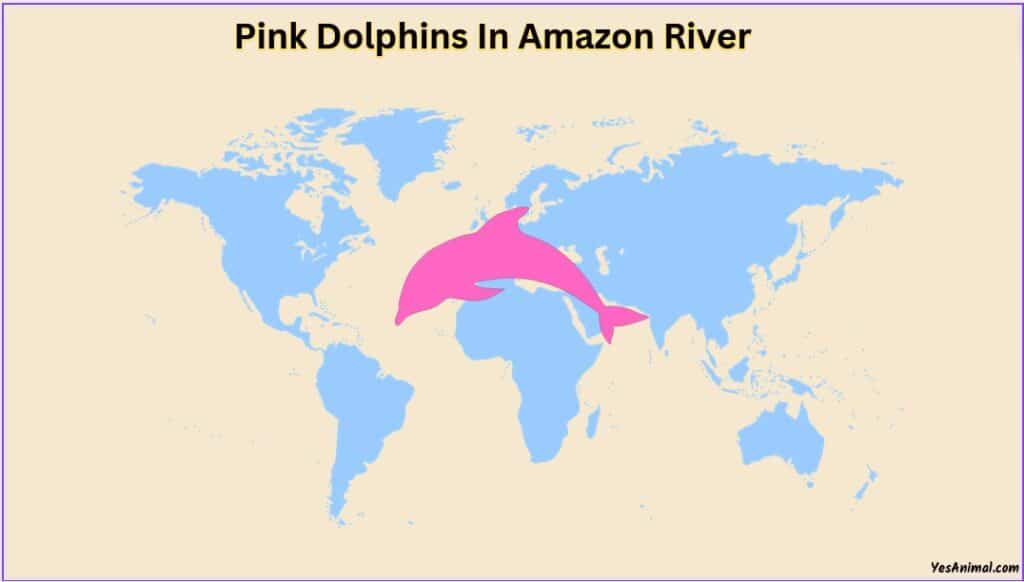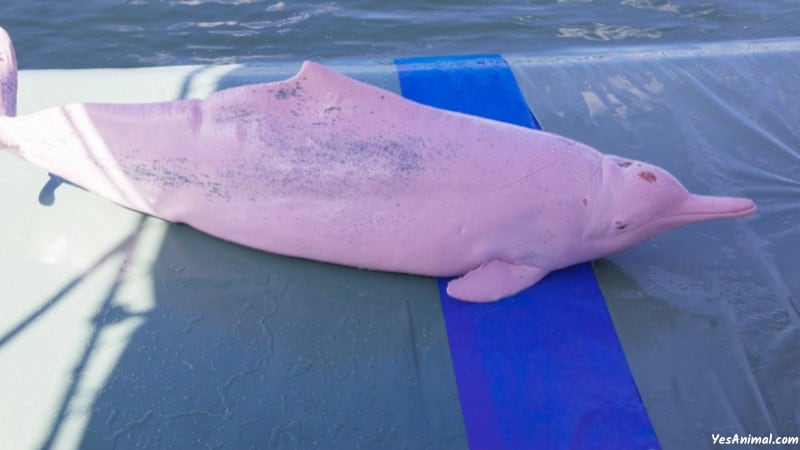Last Updated on September 14, 2023 by Amin Tawar
Are There Pink Dolphins In Amazon River?

Yes, there are pink dolphins in the Amazon River and they are rare and gorgeous creatures. They are one among the two endangered species of freshwater dolphins that are seen in the Orinoco and Amazon river basins.
The habitat area of the pink dolphin reaches much of its freshwater habitat area, from the eastern rim of Brazil to Peru. These dolphins are spread across 4 nations including Bolivia, Ecuador, Colombia, and Venezuela.
In South American culture, pink dolphins are considered mythical creature that is reviled and revered in similar measure. Pink dolphins are the biggest of the four river dolphin species, reaching up to 8 feet in length and over 450 pounds. They have strong flippers and tail flukes and an altered hump in place of a dorsal fin.
Why Are The Dolphins Pink In The Amazon?
Though pink dolphins in the Amazon River are known for their bubblegum-pink hue, they were not born this way. Dolphins are born gray and gradually turn pink as they get older. Male dolphins are pinker than their female partners.
The coloration is believed to be because of scaring tissues from fighting or rough games over conquests. However, the color is influenced by their capillary placement, behavior, and exposure to sunlight.
Also, scientists who study the color variation of these dolphins tell that it is a sign of albinism. Albinism occurs when cells that usually make the pigment melanin, liable for skin, eye, and hair color fail to produce it at standard levels.
These pink dolphins can wear markings that vary from gray to a few pink spots, to complete flamingo pink. The more radiant the pink, the more appealing the male dolphins are to female dolphins—at least in the mating season.
How Many Pink Dolphins Are Left In The Amazon?
The exact population of pink dolphins in the Amazon River is difficult to estimate. Given their huge habitat range, yet with a few hotspot locations, it is difficult to determine the exact figure of the population.
Roughly there are over 10 thousand individuals in the Amazon River. As this might not sound like a lot, the pink dolphins were added to the red list of endangered species. This is because the population has been on a decline since 2000. The decline in water quality, pollution of the Amazon River, and overhunting are the major factors for the population decline.
What Do Pink Amazon Dolphins Eat?

Pink dolphins have a very diverse diet among the toothed whales. They eat over 53 species of fish, that are sized anywhere from 5 to 80 cm. The most often consumed fish are Sciaenidae, Characidae, Cichlidae, and Serrasalmidae.
Their teeth let them chew on the shells of turtles and freshwater crabs. Diet during the wet season is more diverse as fish availability is very less in the center. Likewise, their diet is more selective in the dry season as prey density increases. They consume food that is over 5% of their body weight each day.
Also, Check Our Guide On Dolphins In Massachusetts
Can You Swim With Pink Dolphins?
Yes, you can swim with pink dolphins. Manaus is one of those few places along the Amazon River in Brazil, where you can swim with pink dolphins. Here, you get to swim with these Amazon creatures in their natural habitat.
How Long Do Pink Dolphins Live?
Pink dolphins in the Amazon River are known to live up to 30 years old. This hugely, depends on their diet and the water, as pink dolphins prefer living in freshwater habitats. As the Amazon water is getting polluted because of the highly toxic chemicals, this can impact the life span of the pink dolphins. It can increase the chances of many health issues including cancer and even lower their fertility and immune systems.
What Are Pink Dolphins Hunted For?
For many decades, fishermen have been utilizing pink dolphins in the Amazon River as bait for catfish. As pink dolphins are large with plenty of meat, fishermen poach them to set up baited traps to collect huge numbers of catfish. Pink dolphins’ meat stays for long periods and attracts plenty of catfish, resulting in valuable hauls.
This approach was so flourishing that thousands of pink dolphins in the Amazon River were slaughtered to use as catfish bait. Brazil has banned this practice to help prevent the poaching of pink dolphins, and it did help.
But, the illegal killing continued. Currently, the prohibition on catfish fishing has been raised, and conservationists worry that it can increase the harvest of pink dolphins to catch catfish.
Conclusion
And that was everything you need to know about the Pink Dolphins in Amazon River. I hope this article answered all your queries.
Our Source For This Guide.